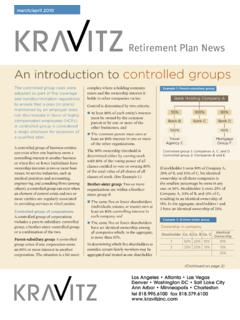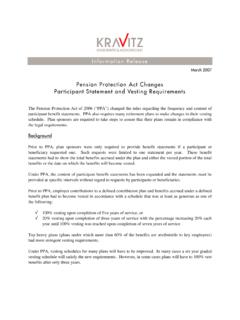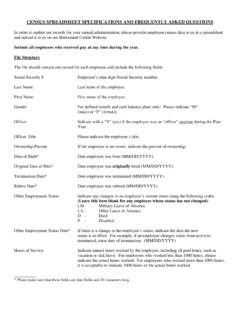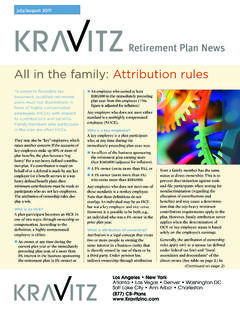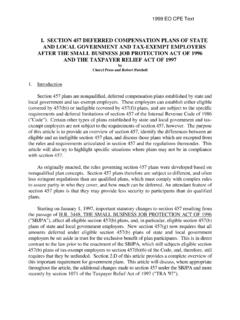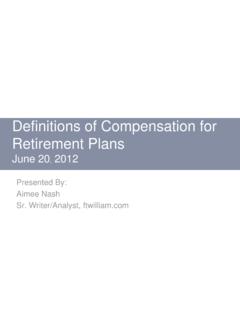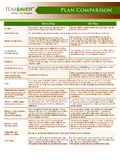Transcription of Correcting missed required minimum distributions
1 January/february 2016(Continued on page 2)Internal Revenue Code (IRC) Sec-tion 401(a)(9) requires every qualified plan to provide required minimum distributions (RMDs) as soon as a participant reaches his or her required beginning date (RBD). Generally, the RBD is April 1 of the year after the participant reaches age 70 , though it may be later if a non-5% owner continues to work after age 70 . If an individual worked at seven jobs during his or her career and left money in seven different 401(k) plans, each plan is required to distribute RMDs to the individual. In the event of a partici-pant s death, the plan is required to follow the minimum distribution requirements for beneficiaries.
2 Failure to distribute an RMD may result in plan disqualification and/or the imposition of a 50% excise tax on the participant or beneficiary. This article will explain the correction process that is available when a qualified plan fails to timely distribute an RMDs from qualified plansMistakes can happen. For example, an employee s date of birth may be incor-rectly recorded in the recordkeeping sys-tem, inadvertently causing the employer and plan administrator to be unaware of the year that the employee attained age 70 . Or an employee s data may have been lost in an implementation, merger, or discovery of a missed RMD, all appropriate steps should be taken to rem-edy the situation as soon as possible.
3 Spe-cifically, RMDs should be calculated for all years since the participant attained age 70 and to the extent the RMDs were not distributed immediately distributed along with calculated earnings. If the employer files under the IRS s Voluntary Correction Program (VCP), the employer may request that the IRS waive the excise tax imposed on the missed RMDs. Excise taxAs noted, a participant or beneficiary who does not receive a full RMD for a distribution calendar year is subject to an excise tax of 50% on the underpay-ment pursuant to IRC Sec. 4974. For example, assume an RMD is calculated to be $3,200 for 2015, but the participant received only $2,000.
4 The underpayment of $1,200 is subject to the 50% penalty, so a penalty of $600 must be added to the participant s taxes due for 2015. The $1,200 still has to be withdrawn, subject to income taxes (assuming the entire dis-tribution consists of pretax funds). The participant files IRS Form 5329, Additional Taxes on qualified Plans (Including IRAs) and Other Tax-Favored Accounts, with his or her federal income-tax return for the year in which the error for waiver of the 50% penaltydue to reasonable causeIf there was a reasonable cause for the failure to take the RMD, the individual Correcting missedrequired minimum distributionsLos Angeles New YorkAtlanta Las Vegas Denver Washington DCSalt Lake City Ann Arbor Charleston(877) plan NewsCorrecting missed required minimum distributions (Continued from page 1)may ask for the penalty to be waived on Form 5329.
5 The IRS will review the information provided and decide whether to grant the request for the waiver for certain beneficiariesAn automatic waiver may be available in situations where an individual is the sole beneficiary of a participant s benefit or of a separate share. If the amounts are payable under the life expectancy method and a payment is missed during the first five years, the excise taxes are waived if the total death benefit is paid under the five-year RMD failures using the Employee Plans Compliance Resolution System (EPCRS)The EPCRS provides a streamlined procedure for Correcting missed RMDs using Form 14568-H, Appendix C Part II Schedule 8, Failure to Pay required minimum distributions Timely under 401(a)(9).
6 As part of the VCP submission, the plan sponsor is able to request the waiver of the participant level excise tax imposed under IRC Sec. 4974. Fee schedule for RMD failuresIRS Revenue Procedure 2015-27 recently updated the VCP fee for missed RMDs, amending it to $500 for missed RMDs involving 150 or fewer participants. The compliance fee is $1,500 when 151 to 300 participants are involved. If more than 300 participants failed to receive RMDs, the IRS s general fee schedule, which is based on the number of participants in the plan , will be includes distribution of missed RMDs plus earningsIn a defined contribution plan , the permitted correction method is to distribute the missed RMDs with earnings from the date of the failure to the date of the distribution .
7 If more than one year s RMD has been missed , the amount required to be distrib-uted is the RMD for each year, starting with the year in which the initial failure occurred. Amounts are determined by dividing the adjusted account balance on the applicable valuation date by the applicable distribution period and then calculating the earnings for each missed : A defined contribution plan missed an individual s RMDs for 2013, 2014, and missed RMD for 2013 would be calculated as follows: December 31, 2012, fair market value (FMV) $100,000 (age 72) = $3, *The missed RMD for 2014 would be calculated as follows: December 31, 2013, FMV $108,000 $3, (age 73) = $4, * The missed RMD for 2015 would be calculated as follows.
8 December 31, 2014, FMV $115,000 $3, $4, (age 74) = $4, ** Gains/losses are calculated on each RMD from the date the funds should have been distributed until the actual distri-bution date. 2016 COLA limitsThe IRS has released the cost-of-living adjustments (COLAs) applicable to the dollar limitations for pension plans (and other items) for the 2016 tax year. Many of the limits remained the same as they were for 2015. IRS limits2016 2015401(k), SARSEP, 403(b), and 457 plan deferrals/catch-up $18,000/$6,000 $18,000/$6,000 SIMPLE plan deferrals/catch-up$12,500/$3,000$12,500/ $3,000 Compensation defining highly compensated employee*$120,000$120,000 Compensation defining key employee/officer$170,000$170,000 Defined benefit plan limit on annual benefits$210,000$210,000 Defined contribution plan limit on annual additions$53,000$53,000 Maximum compensation limit for allocation and accrual purposes$265,000$265,000 Individual retirement account (IRA)
9 Contributions/catch-up$5,500/$1,000$5,50 0/$1,000 SEP minimum compensation for an allocation$600$600 QLAC maximum $125,000$125,000 SSA compensation limit$118,500$118,500* 2015 amount for use in 2016 plan year testsTraditional IRA: AGI phaseout range for deductionActive participants filing a joint return (or a qualified widow(er))$98,000 to $118,000 $98,000 to $118,000 Single or head-of-household$61,000 to $71,000$61,000 to $71,000 Married couples filing separately$0 to $10,000$0 to $10,000 Taxpayer not active participant,spouse is active participant $184,000 to $194,000 $183,000 to$193,000 Roth IRA: AGI phaseout range for eligibility to contribute Married taxpayers filing a joint return (or a qualified widow(er)) $184,000 to $194,000 $183,000 to$193,000 Single taxpayers $117,000 to $132,000 $116,000 to $131,000 Congress has devised several types of nondiscrimination tests designed to prevent qualified retirement plans from favoring highly compensated employees (HCEs) by more than de minimis amounts.
10 The first test to perform is the coverage test, which ensures that the plan benefits a suf-ficient number of non-highly com-pensated employees (NHCEs). Once the coverage test is passed or, if the test is not passed, once the necessary steps have been taken to correct the failure then the aver-age deferral percentage (ADP) test may be performed. The ADP test is designed to ensure that HCEs do not receive a disproportionate the coverage test and the ADP test are performed annually. These tests entail the use of mathematical formulas to com-pare the eligibility and contribution rates of HCEs and NHCEs and to determine whether the plan is discriminating in favor of the is an HCE?

